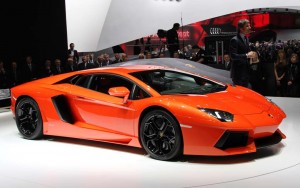
Lamborghini offsets the added performance of the new Aventador with the use of super-light carbon fiber.
If you want anything faster you might have to hitch a ride off an aircraft carrier. The new Lamborghini Aventador’s 700-horsepower V12 can propel the supercar from 0 to 100 kmh (62.5 mph) in just 2.9 seconds, about as fast as a skydiver accelerates during freefall.
Performance is the watchword for the Italian brand, whose emblem is a raging bull – indeed, the new Aventador was named after a legendary fighting bull. Yet for all the emphasis on power and speed, the Volkswagen subsidiary cannot ignore the issue of what CEO Stefan Winkelmann calls “social acceptance.”
“We can’t turn the clock back” to the days when brands like Lamborghini could ignore mounting concerns about the environment, Winkelmann tells TheDetroitBureau.com. “We have to do something about social acceptance.”
And that could lead to some surprising moves by the supercar maker, perhaps even the introduction of a hybrid-electric powertrain as it moves forward with plans to add a third model to its current, two-platform line-up.
Lambo has set a goal of reducing the CO2 output of its various models by 35% over the next product cycle. That might come as a surprise considering that the new Aventador delivers significantly more power than the outgoing Lamborghini Murcielago, the “base” model of which came in at just 580 hp – with even the topline LP640 rated at “just” 640 horsepower.
Yet the new flagship model cuts fuel consumption by about 20%, according to Lamborghini.
Improved engine design certainly helps, but a critical step came with the switch to strong yet extremely light carbon fiber for the Aventador’s monocoque and other key components.
“We have to find ways to reduce weight,” stresses Winkelmann, and that’s a key to getting there, he adds, noting that the new supercar is about 200 pounds lighter than the one it replaces.
The challenge, he cautions, is finding a way to also reduce the hefty cost of carbon fiber, which has traditionally been so high as to preclude the use of the material on anything but the most exclusive exotics. But that could be changing.
BMW AG, for example, makes extensive use of carbon fiber on the new Mini Rocketman, a concept vehicle it also previewed in Geneva. The German maker has invested in new production processes that could drive the cost down sharply and allow the use of the composite material on more mainstream products. (For more, Click Here.)
That could prove useful as Lamborghini moves forward on the development of a third model line which would likely slide “under Gallardo,” the current “entry” model in the Lambo line-up. The go/no-go decision will made “by the end of this year,” Winkelmann tells TheDetroitBureau.com, which would suggest a production target sometime between 2014 or 2015.
Even as that new offering is under development, Lamborghini is looking at another possible project that some might call downright heretical. “We could imagine a hybrid” for the line-up, confides the German-born CEO.
That’s not entirely far-fetched. A number of Lamborghini’s key competitors are moving forward with plans to adopt gasoline-electric technology, including Ferrari, Lotus and Porsche, the latter showing off its new Panamera S Hybrid on its stand at the Geneva Motor Show.
Porsche is also developing a hybrid race car, the 918 RSR, which it unveiled at the Detroit Auto Show, in January. (For more, Click Here.)
Which suggests that Lamborghini, which likes to view itself as “the benchmark,” according to Winkelmann, will have to move ahead on that technology or risk being left behind.
For more on the Lamborghini Aventador, Click Here.

In Engine-Expo-International June 2009, the heads of the VW group, Daimpler, BMW, Toyota, …who had come to collect (in the Show/Fair of the Engine-of-the-Year awards) their awards, were given a letter writing that a Honda Civic 1600cc engine-car has been modified to make 250 hp (naturally aspirated), idle at 330 rpm and running greener than a 50 hp family car because it has a flat torque curve from 900 to 9k rpm so that it mostly runs on fifth gear, even in downtown (http://www.pattakon.com/pattakonRoller.htm )
The Engineers of the Aston Martin who were presenting their Super Car ONE-77 were told that with the Desmodromic Fully Variable Valve Actuation system exhibited at pattakon booth, the same car could be half as a gas-guzzler, more powerful and way more pleasant to drive in downtown. They said they were going to make only 77 of them.
As long as Lamborghini plants to make more than 77, it takes nothing to take a look at the Desmodromic VVA (DVVA) at http://www.pattakon.com/pattakonDesmo.htm .
Thanks
Manousos Pattakos